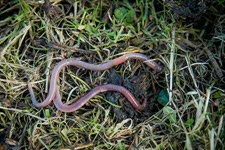Mestinjectie schaadt weidevogels via hun voedsel
Op weilanden waar drijfmest in de bodem is geïnjecteerd, zijn minder wormen beschikbaar dan op weilanden waar ruige stalmest is opgebracht. Door het opensnijden van de grasmat tijdens het injecteren, droogt de toplaag zo sterk uit dat de wormen zich niet meer aan het oppervlak laten zien. In dergelijke weilanden hebben de weidevogels die van wormen leven duidelijk minder te eten. Dat laat onderzoeker van de Rijksuniversiteit Groningen Jeroen Onrust zien in een publicatie in het wetenschappelijk tijdschrift Journal of Applied Ecology.
Bodemvocht sleutel tot wormenbeschikbaarheid
Een vochtige toplaag van de bodem zorgt ervoor dat regenwormen naar boven komen én dat weidevogels met hun snavel in de grond kunnen prikken om wormen te pakken te krijgen. “Om wormen en weidevogels in verdroogde weilanden te helpen wordt vaak vooral de grondwaterstand verhoogd”, vertelt RUG-onderzoeker Jeroen Onrust. “Maar als de bodem door onder andere mestinjectie al is verstoord, droogt de toplaag in het voorjaar zo snel uit dat een hoger grondwaterpeil niet meer helpt”, vult professor dr. Theunis Piersma aan.
Grondwaterstandverhoging zou dus gecombineerd moeten worden met een andere manier of moment van bemesten.

Rode en grijze wormen
In Nederlandse weilanden komen twee typen regenwormen voor: de grijze Aporrectodea caliginosa leeft in de grond van de bacteriën die op gronddeeltjes zitten. De rode Lumbricus rubellus pendelt op en neer tussen de diepere bodem en het oppervlak, waar hij bijvoorbeeld plantenresten ophaalt om die dieper in de bodem te verteren. Door dit gedrag zijn vooral rode wormen van belang voor een goede bodemstructuur en als voedselbron voor weidevogels.
Van het veld naar het laboratorium
In een eerdere publicatie dit jaar in Agriculture, Ecosystems and Environment liet Onrust al zien dat in met drijfmest geïnjecteerde weilanden minder rode wormen voorkomen dan in weilanden waar ruige stalmest wordt opgebracht. Om uit te sluiten dat de weilanden met ruige stalmest ook om andere redenen beter waren voor wormen deed Onrust enkele experimenten in het lab. “We hebben jonge grijze en rode wormen vijf maanden op een dieet van drijfmest, ruige mest of gewoon stro gezet. Daaruit bleek duidelijk dat de rode wormen minder hard groeiden op drijfmest dan op ruige mest. Zo leidt het insnijden van drijfmest op twee manieren tot het verdwijnen van de ecologisch belangrijke rode wormen: hun favoriete voedsel groeit minder goed en door de droogte zitten de wormen te diep voor de vogels."

Publicaties
- Onrust, J. & Piersma, T. (2019) How dairy farmers manage the interactions between organic fertilizers and earthworm ecotypes and their predators. Agriculture, Ecosystems and Environment 273, 80-85: https://doi.org/10.1016/j.agee.2018.12.005
- Onrust, J., Wymenga, E., Piersma, T. & Olff, H. (2019) Earthworm activity and availability for meadow birds is restricted in intensively managed grasslands. Journal of Applied Ecology: https://besjournals.onlinelibrary.wiley.com/doi/10.1111/1365-2664.13356
Meer nieuws
-
11 december 2025
Stormachtige planeten en een onverwachtse atmosfeer
-
09 december 2025
RUG-hoogleraar bij COP30: ‘Het is altijd drama’
